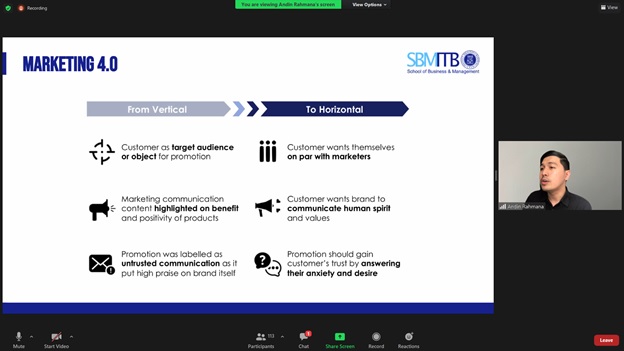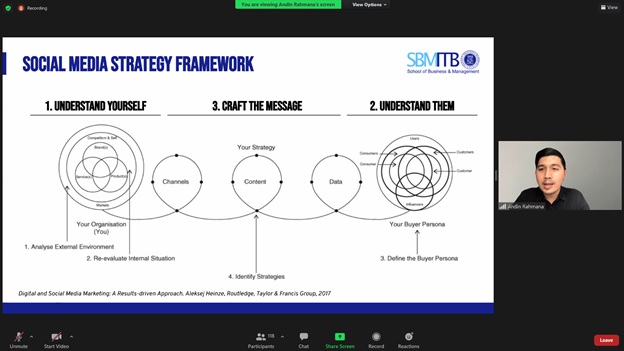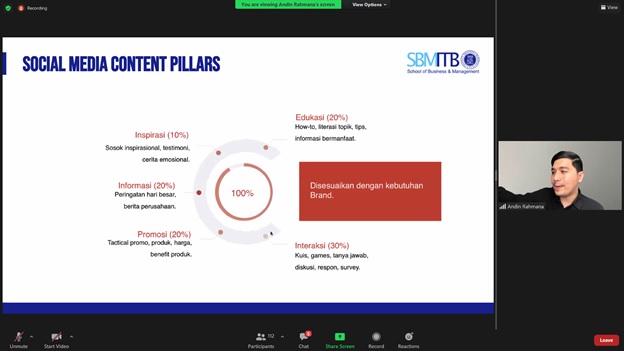For most people, creating social media is easy, but the question is, how do we optimize social media to be a useful tool for our marketing strategy?
For this reason, SBM ITB presents the Academic Head of Digital Marketing and Digital Marketing Lecturer/ Trainer from Purwadhika Digital Technology School, Andin Rahmana as a guest lecturer in the class majoring in International Business.
 Winning the hearts of netizens through social media is tricky. To attract the target market’s attention, we need to find the “sweet spot” or effective social media content. This can only be accomplished by striking a balance between what the company is attempting to communicate and what netizens want to read, hear, or consume.
Winning the hearts of netizens through social media is tricky. To attract the target market’s attention, we need to find the “sweet spot” or effective social media content. This can only be accomplished by striking a balance between what the company is attempting to communicate and what netizens want to read, hear, or consume.
Andin, a Digital Strategist and Co-Founder of CikalBakal Creative, also quoted Jonah Berger’s STEPPS theory from his book “Contagious”. He mentioned six examples of shareable content that can be used:
- Social currency, where people consider how others perceive them.
- Trigger, where people share things that can make other people move.
- Emotion, sharing things about caring or touching people’s hearts.
- General information for the general public.
- Practical value, sharing information that may be useful to others.
- Stories, information about everyday life, such as travel.
“Generally, there are several pillars that can be implemented based on the company’s needs. Content that educates, inspires, provides information, promotions, and interactions are among them,” said the man, who has worked with clients, such as Telkomsel, UOB, AIA, Sinarmas, Trans TV, Kompas Gramedia, Bank Mandiri Syariah, PLN, and others.
 It is hoped that appropriate social media content will become a thumb-stopping or make netizens pause for a moment.
It is hoped that appropriate social media content will become a thumb-stopping or make netizens pause for a moment.
The content must also be neatly and attractively wrapped. Content creators must consider the following factors:
- Copywriting, the writing should be easy to read, clear, and informative. You must also understand when to use a long or short story.
- Visuals, the images viewed must be appropriate, unique, and/or different in the viewer’s opinion.
- Videos, by paying attention to the duration, pieces of images can be inserted or elaborated with good stories, emotional or functional.
Social Media Interaction
The majority of Indonesians already use social media in their daily lives. Indonesians spend an average of 8 hours and 52 minutes per day on the internet, 2 hours and 50 minutes per day watching television, and 3 hours and 14 minutes per day using social media. Based on this data, we can conclude that Indonesians prefer social media to other internet functions.
To fully realize this potential, we must first understand the differences between social media communication patterns and other traditional mass media forms. Traditional media is essentially a one-way street, and social media communication patterns, on the other hand, are more horizontal or two-way. In comparison, netizen participation requires us to be more interactive and better understand our market.
Today’s marketing strategy has shifted as a result of this new approach. We no longer send out general brochures or notices, and we, on the other hand, take a more interactive approach with customers.
“Today, one brand competes with another brands to interact with the community. With non-formal and relevant content that is close to people’s daily lives, they can win the hearts of many people,” said a graduate of Gadjah Mada University and the University of Oxford.
Andin also stated that it is critical to creating relevant content following current trends. For example, the contents of “Langit Bisakah Kau Turunkan Hujan dan Petir”, “Salam Dari Binjai”, to current popular films and songs. In addition to trends, we can use wordplay to create a humorous impression.
 However, it is undeniable that not everything we give is accepted as expected. There are times when we are confronted with dissatisfied customers or individuals. If we receive a complaint, we should try to be empathic, listen carefully, be responsible, explain clearly, and provide solutions. Don’t forget to say thank you at the end for your advice on future development.
However, it is undeniable that not everything we give is accepted as expected. There are times when we are confronted with dissatisfied customers or individuals. If we receive a complaint, we should try to be empathic, listen carefully, be responsible, explain clearly, and provide solutions. Don’t forget to say thank you at the end for your advice on future development.
When we receive a large amount of negative feedback, it’s best to step away from all social media activities for a moment to reflect. Discuss it with stakeholders as soon as possible to find the best solution for everyone. Don’t forget to monitor sentiment volume with social media listening tools.
Written by Student Reporter (Erwin Josua, EMBA 2021)




